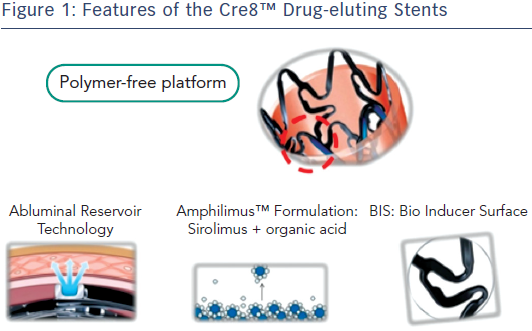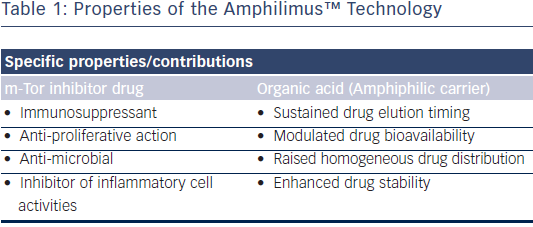The use of coronary artery stents was first described in 1986, and percutaneous coronary intervention (PCI) invol ving stenting is now routine practice. However the problem of restenosis, caused by neointimal tissue growth, led to the development of drug-eluting stents (DES), which allow controlled release of antiproliferative drugs at the arterial wall.1 The use of DES has significantly improved clinical outcomes compared to bare metal stents (BMS).2,3 But safety issues emerged with the use of DES. These were late stent thrombosis due to delayed arterial healing of the stented segment, characterised by inflammation at the stent site with uncovered stent struts.4 This is caused by the persistence of durable polymers used in first generation DES. Once the drug is fully eluted, the polymers continue to interact with the vascular endothelium.
ving stenting is now routine practice. However the problem of restenosis, caused by neointimal tissue growth, led to the development of drug-eluting stents (DES), which allow controlled release of antiproliferative drugs at the arterial wall.1 The use of DES has significantly improved clinical outcomes compared to bare metal stents (BMS).2,3 But safety issues emerged with the use of DES. These were late stent thrombosis due to delayed arterial healing of the stented segment, characterised by inflammation at the stent site with uncovered stent struts.4 This is caused by the persistence of durable polymers used in first generation DES. Once the drug is fully eluted, the polymers continue to interact with the vascular endothelium.
Stent technology continues to evolve, and the development of secondgeneration DES with novel or biodegradable polymer coatings and/ or bioabsorbable struts has improved the safety profile of DES.5 A symposium, chaired by David Antoniucci and Roxana Mehran, at EuroPCR on 23rd May 2014 in Paris focussed on the Cre8™ DES (Alvimedica), a novel polymer-free stent designed to address the issues associated with early DES use (see Figure 1). The Cre8 features a polymer-free structure to reduce the risk of inflammation associated with durable polymers and the breakdow n products of absorbable biopolymers. A drug delivery system, Abluminal reservoir technology, utilises a formulation of sirolimus and a fatty acid (Amphilimus™) that enhances bioavailability and drug distribution to the entire vessel wall (see Table 1). In addition, the bio inducer surface, a second-generation integral pure carbon coating, is designed to accelerate stent endothelialisation and strut coverage that reduces the risk of thrombosis. The NEXT clinical trial demonstrated the efficacy and safety of Cre8,6and has suggested that this DES may be useful in cases with complex anatomy. This symposium aimed to demonstrate the use of Cre8 in patients with dual antiplatelet therapy constraints, to review the clinical issues related to patients undergoing PCI at high risk of restenosis and to understand PCI strategies for the above patients, through the discussion of two case studies.
n products of absorbable biopolymers. A drug delivery system, Abluminal reservoir technology, utilises a formulation of sirolimus and a fatty acid (Amphilimus™) that enhances bioavailability and drug distribution to the entire vessel wall (see Table 1). In addition, the bio inducer surface, a second-generation integral pure carbon coating, is designed to accelerate stent endothelialisation and strut coverage that reduces the risk of thrombosis. The NEXT clinical trial demonstrated the efficacy and safety of Cre8,6and has suggested that this DES may be useful in cases with complex anatomy. This symposium aimed to demonstrate the use of Cre8 in patients with dual antiplatelet therapy constraints, to review the clinical issues related to patients undergoing PCI at high risk of restenosis and to understand PCI strategies for the above patients, through the discussion of two case studies.